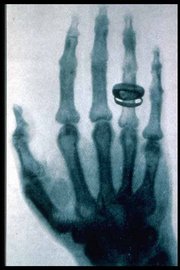The watch radiographs on the other page were obtained using equipment designed for humans. If I were to have used industrial x-ray technique, the images would have been sharper, but in human use, in order to reduce dose to the person, various modifications are in place. Image quality usually is reduced somewhat. In industrial radiography, for example taking an x-ray of a jet engine fan blade, no one cares about dose, so technique is optimized. If these watches were filmed with industrial equipment, the clarity would be better. Overall, it's not bad, you still can see a lot of the movement. The first watch was filmed with double emulsion extremity film, 200 milliAmperes current, and 80 kilovolts charge separation across the x-ray tube. Exposure time was 100 or 200 milliseconds. The second film used 200 mA, 110 kv, and 500 ms technique.
X-rays were discovered in November 1895 by Wilhelm Roentgen, in Wurzburg, Germany. Roentgen, who was born an Austrian, was testing discharge from cathode ray tubes. He covered the glass tube to prevent any light from escaping, for some sort of experiment. Unrelated directly to this experiment, he had some glass plates laying around, which had been coated with a fluourescent material. He noticed that the coated glass plates glowed when he turned on power to the tube. The tube was covered completely with heavy dark paper, so he knew that no ordinary light was escaping from it. But clearly something was being generated by the tube, and interacting with the plates. He realized that he had discovered some sort of 'new light.' As part of his further experimentation, his hand momentarily got between the tube and the fluourescent plate, and he saw a fleeting shadow cast by his hand. He tried it again, and to his mild horror, he saw the shadow of his flesh and bones cast against the plate. At first, he thought he hallucinating. He showed the effect to his wife, the only person he trusted to not think him mad. Bertha confirmed his observation. He took the first xray picture, an image of her hand. Bertha was so appalled by the death-like appearance of her hand, that she never went near his laboratory again. Althought it was sort of serendipetous, Roentgen's discovery nevertheless wasn't really an 'accident.' It required observation and insight - 'chance favoring a prepared mind.' Indeed, X-rays as they were later called, had been unknowingly generated in other labs before, but the effects were attibuted to faulty equipment or 'experiemental flukes.' The investigators were unable to recognize the importance of their results.


